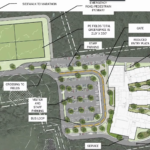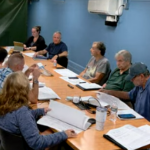The 1657 will of Connecticut Gov. Edward Hopkins allocated money for New England schools, and in 1713, a British decree established the Charity of Edward Hopkins to manage the Hopkins legacy and to allocate funds for Harvard College and Cambridge Grammar School. Edward Hopkins’ will bequeathed money for “the breeding up of hopeful youth in the way of learning both at ye Grammar School & College for the Public Service of the Country in future times.”
One of the first transactions of the Hopkins Trustees was the purchase of land from the Natick Nipmuck tribe on Oct. 11, 1715. This land was incorporated as the Town of Hopkinton on Dec. 13, 1715. The Hopkins trustees were actively involved as landowners and municipal administrators of Hopkinton until 1832, when the Commonwealth of Massachusetts and the tenants jointly paid the trustees for the release of their land rights.
James Gordon was born in 1693 in County Down, Ireland, and traveled to Boston about the year 1718. He was a successful merchant who imported Irish linen products. When he arrived, he served as one of the first constables in Boston. In 1723, he bought pew No. 62 in Boston’s King’s Chapel. By 1736, his status in the church had risen to the point that he became the chapel’s first warden. Gordon died on May 24, 1770, at the age of 77. Because of his prominent position in the church, he was buried beneath the chapel in Tomb 8, near Thomas Bullfinch.
Gordon’s success allowed him to become a land speculator and landlord who leased or purchased lands in various sections of Massachusetts in the early to mid-1700s. Around 1720, he leased six plots of raw land in Hopkinton from the Hopkins trustees. During this time, there was a great amount of migration from Scotland to New England, and James Gordon brought several Scottish families to the untamed hills of Hopkinton. These poor farmers signed letters of indenture that allotted them plots of raw land in and around Lake Maspenock. They were indentured for the term of 103 years, ending in 1823.
These hardy souls moved their families, cleared the land and built the first farms in town. On Sept. 2, 1724, a congregational church was organized in Hopkinton. Seven of the original members of this church were Scottish Presbyterians who were indentured to Gordon. Five other Scottish families soon joined them. The beginnings of the church were informal, and no real discussion of church government was had at the outset. These families only conscientiously assented to the covenant and united in Christian communion but without much form of organization. They worshipped together in peace for seven years until April 9, 1731, when the church elders voted to comply with the “Platform of Church Discipline” that had been agreed to by the synod of churches in Cambridge. There was great offense to this vote from the Scottish Presbyterian families, and 10 of the families immediately withdrew from the communion of the church. They were brought under church discipline, and eventually they were excommunicated from the church they had helped found.
The records of the First Congregational Church in Hopkinton contain the names of those who were excommunicated. William Dunahy, Robert Hambleton, Jane Wark, Rebecca Wark, John Hambleton, Israel Gibbs, Mary Gibbs, Hugh Hambleton and Mary Hambleton all were indentured tenants of James Gordon and excommunicated. Shunned and isolated, they continued to farm their fields in Hopkinton for another three years.
In 1734, after 14 years of living and farming in Hopkinton, these families all left town with their animals and belongings in tow and traveled through the harsh wilderness approximately 90 miles west to the mountainous area of what is now Blandford, where they had leased land. On the day of their arrival, a severe snowstorm commenced and continued for three days, leaving a body of snow on the ground to a depth of 3-4 feet. The only shelter they could find in the forest was under the protective boughs of the pines and hemlocks. The snow soon began to melt, and they were then able to clear away trees and erect temporary cabins. They named their new settlement New Glasgow, as they were promised a church bell from the city of Glasgow, Scotland, if they would name their town after it.
They quickly organized a Presbyterian church and built a small meetinghouse. As the community began to grow in population, the residents desired to be incorporated as a town. As a final hardship for these poor Scots, when the village of New Glasgow applied for incorporation in 1741, Gov. William Shirley noticed that they had added an extra square mile to the township survey, so as punishment, he made them call the town Blandford, named for the ship that had brought Shirley to America from England. New Glasgow never received her bell.






















Very interesting! Thank you!
Love it. I’m curious; does anyone know where was/is the location of land purchased from the Natick Nipmuck?
Hello,
I enjoyed reading Mr. Cormier’s informative article but would like to respectfully add some information pertains to the land purchase made in 1715 leading to the incorporation of our town.
I am the Historical Society’s archivist and several of us have been studying copies of primary source documents pertaining to the original land purchase leading to the incorporation of the town.The land ( what is now Hopkinton and parts of Ashland) was purchased from a small village called “Magunco”, inhabited by “Christian” indigenous people, families probably about 50 individuals.These people were affiliated with Native “Praying Indians” and were under their supervision. The Magunco people were descendants of or formerly Nipmuc people but no longer were referred to in that way. The Nipmuc people or “tribe” were disempowered by King Phillips’ War and by previous introduction of diseases and conflicts with other neighboring Native groups and as an entity were not involved with the land sale. The Magunco village or settlement was approximately located where the current commuter rail in Ashland. Thank you for publishing the informative and interesting article by Mr. Cormier, however there is some misunderstanding as to who the Megunco were as they were no longer part of the Nipmuc. We invite the public and Mr. Cormier to take a look at these fascinating letters! .
Hi Linda, Thank you for the correction. The original source documents have been digitized here: https://hollisarchives.lib.harvard.edu/repositories/4/resources/4383
I found this letter to be quite interesting “To the most honorable Samuel Sewell and all those men at the meeting on Monday last, that we are just poor Indians and are not willing to sell our land or to part with it in any ways”
https://iiif.lib.harvard.edu/manifests/view/drs:42994612$1i